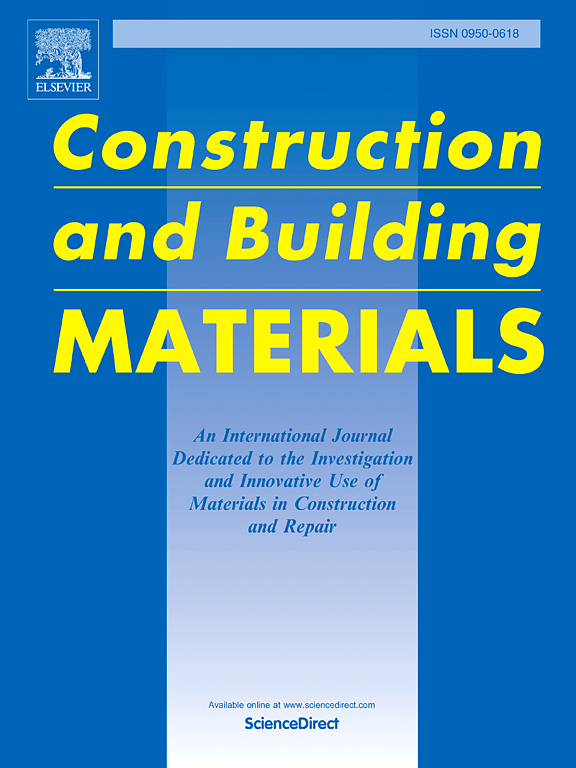Plastic damage assessment of Q690 high strength structural steel derived from the eddy current array technique
IF 8
1区 工程技术
Q1 CONSTRUCTION & BUILDING TECHNOLOGY
引用次数: 0
Abstract
This paper reports a novel use of eddy current array technique to assess the plastic damage of a high strength Q690 steel. The eddy current array parameters can not only effectively judge the severe damage area but also can characterize the early plastic damage of specimens. Under a detection frequency of 375KHz, the mean axial voltage increased from begin-stretch (0.01 V) to fracture (1.83 V). Meanwhile, the digital image correlation tests showed that the strain value increased from 0 % to 14.785 % at this process. Coherently, it was found that the eddy current array parameters had a certain linear relationship with the strain degree. Besides, the microstructure observation revealed that the voids generation/growth as well as the dislocation structure/density change in Q690 steel aggravated with the strain degree. In the early plastic deformation stage, the void defect could be the influence factor to the change of eddy current array parameters, since the axial voltage exhibited a significant increase in relation to both void area fraction and number density, ranging from 0 % to 1.519 % and 11.636 × 104/mm², respectively. In later stage, the change of voltage could be due to the joint effect of void factor and dislocation factor, since its growth from the void defect slowed down, while it increased steadily with the increase of GND density, ranging from 2.12 to 6.31 × 104/m2. In summary, the current array eddy technique could be an effective detecting method, which can characterize the plastic damage degree of Q690 steel even at the early stage.
基于涡流阵列技术的Q690高强度结构钢塑性损伤评估
本文报道了一种利用涡流阵列技术评估高强度Q690钢塑性损伤的新方法。涡流阵列参数不仅可以有效判断试件的严重损伤区域,而且可以表征试件的早期塑性损伤。在375KHz检测频率下,平均轴向电压从开始拉伸(0.01 V)增加到断裂(1.83 V)。同时,数字图像相关试验表明,在此过程中应变值从0 %增加到14.785 %。结果表明,涡流阵列参数与应变程度呈一定的线性关系。显微组织观察表明,随着应变程度的增加,Q690钢中空洞的产生/长大以及位错组织/密度的变化均有所加剧。在塑性变形初期,空洞缺陷可能是影响涡流阵列参数变化的因素,轴向电压随空洞面积分数和空洞数密度的增加而显著增加,分别为0 % ~ 1.519 %和11.636 × 104/mm²。在后期,电压的变化可能是由于空穴缺陷和位错因素的共同作用,其从空穴缺陷开始的增长速度减慢,随着GND密度的增加而稳步增加,范围在2.12 ~ 6.31 × 104/m2之间。综上所述,电流阵列涡流技术可以作为一种有效的检测方法,在Q690钢塑性损伤的早期阶段就可以对其塑性损伤程度进行表征。
本文章由计算机程序翻译,如有差异,请以英文原文为准。
求助全文
约1分钟内获得全文
求助全文
来源期刊

Construction and Building Materials
工程技术-材料科学:综合
CiteScore
13.80
自引率
21.60%
发文量
3632
审稿时长
82 days
期刊介绍:
Construction and Building Materials offers an international platform for sharing innovative and original research and development in the realm of construction and building materials, along with their practical applications in new projects and repair practices. The journal publishes a diverse array of pioneering research and application papers, detailing laboratory investigations and, to a limited extent, numerical analyses or reports on full-scale projects. Multi-part papers are discouraged.
Additionally, Construction and Building Materials features comprehensive case studies and insightful review articles that contribute to new insights in the field. Our focus is on papers related to construction materials, excluding those on structural engineering, geotechnics, and unbound highway layers. Covered materials and technologies encompass cement, concrete reinforcement, bricks and mortars, additives, corrosion technology, ceramics, timber, steel, polymers, glass fibers, recycled materials, bamboo, rammed earth, non-conventional building materials, bituminous materials, and applications in railway materials.
 求助内容:
求助内容: 应助结果提醒方式:
应助结果提醒方式:


